by Mike Finkel with photography by Marc Muench
Feb 2000, Vol. 4 No. 5
 In addition to state-sponsored misogyny, ill-tempered ayatollahs, and a death sentence on Salman Rushdie, the Islamic Republic of Iran is home to quite a few ski resorts. I learned of the resorts a couple of years ago, when I came across a photo of one in an old National Geographic magazine. I later telephoned the Iranian mission to the United Nations, in New York City. An official there not only confirmed the resorts’ existence, he was driven to near poetry as he described majestic peaks in Iran’s northern highlands and great quantities of light, dry powder, the moisture sucked out of the snow clouds on the trip across the Iranian desert. He mentioned modern ski resorts, with hotels and gondolas and midmountain restaurants, and said tens of thousands of Iranians were avid skiers, men and women included.
In addition to state-sponsored misogyny, ill-tempered ayatollahs, and a death sentence on Salman Rushdie, the Islamic Republic of Iran is home to quite a few ski resorts. I learned of the resorts a couple of years ago, when I came across a photo of one in an old National Geographic magazine. I later telephoned the Iranian mission to the United Nations, in New York City. An official there not only confirmed the resorts’ existence, he was driven to near poetry as he described majestic peaks in Iran’s northern highlands and great quantities of light, dry powder, the moisture sucked out of the snow clouds on the trip across the Iranian desert. He mentioned modern ski resorts, with hotels and gondolas and midmountain restaurants, and said tens of thousands of Iranians were avid skiers, men and women included.
This was a remarkable bit of information. Iran is a country in which most women are forbidden to appear in public without a tent-like chador that conceals all hints of body shape or hair color; where alcohol is prohibited, as is rock music, dancing, jewelry, and anything else deemed un-Islamic by the ayatollahs who run the country; where an Iranian editor whose magazine was shut down by the government said, as quoted in a front-page article in a recent New York Times, “There is deep fear and absolutely no freedom of expression.” It was impossible to imagine these same Iranianans floating blithely down the slopes.
 The man from the United Nations swore his descriptions were accurate. I said I’d like to see the ski areas myself. He informed me that, pending a miraculous shift in U.S.-Iran relations, I was not invited to visit the resorts-nor anyplace else in Iran, for that matter. That pretty much sealed it. I resolved to go.
The man from the United Nations swore his descriptions were accurate. I said I’d like to see the ski areas myself. He informed me that, pending a miraculous shift in U.S.-Iran relations, I was not invited to visit the resorts-nor anyplace else in Iran, for that matter. That pretty much sealed it. I resolved to go.
The United States and Iran have not shared diplomatic relations since the morning of November 4, 1979, when militants seized the American embassy in Tehran, took 52 people hostage, and held them for 444 days. Still, it is not illegal for Americans to visit Iran. Just inadvisable, and difficult. It took me more than a year to obtain a visa. I wrote fawning, bullshitty letters to various Iranian authorities – “I am looking forward to availing myself of the wonderful hospitality of your government”-and masqueraded as a professional skier rather than a magazine writer. (Iranianans are skittish about journalists.) I even worked with an Iranian-born travel agent.
Nevertheless, my first visa application was rejected. My second was held up in the Iranian mission for more than a month. Literally hours before my scheduled flight I finally secured a visa for myself and a California-based photographer named Marc Muench. We departed on February 25.
Iran’s peculiarities began to emerge even before we landed. As the airplane banked toward Tehran International Airport, two announcements were broadcast. First, we were told to set our watches two-and-a-half hours ahead of Paris time. Not two hours, not three, but two-and-a-half. Iran, electing not to cooperate with any of its neighbors and most of the world, has established its very own time zone.
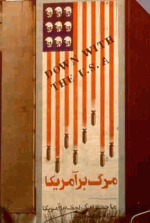 Then came the second announcement: “All women must wear Islamic dress before disembarking from the plane.” Women reached into handbags and overhead compartments and brought out dark-colored shawls and headscarves. They wiped away makeup and covered their heads. What was once a vivid collection of passengers faded into unsettling anonymity. I didn’t see a woman’s hairdo for the remainder of my trip.
Then came the second announcement: “All women must wear Islamic dress before disembarking from the plane.” Women reached into handbags and overhead compartments and brought out dark-colored shawls and headscarves. They wiped away makeup and covered their heads. What was once a vivid collection of passengers faded into unsettling anonymity. I didn’t see a woman’s hairdo for the remainder of my trip.
Our travel agent had arranged a guide and translator, and we were met in the airport lobby by a silver-haired man, a chain-smoker, impeccably dressed in a tan suit and wool sweater. (But not wearing a tie: Ties are seen as symbolic of Western mores, and are therefore unacceptable.) Iran is a formal country; our guide introduced himself as Mr. Atigheh, and that is what we called him. Marc and I insisted it wasn’t necessary to use our surnames, so for the entire visit Mr. Atigheh referred to us as Mr. Marc and Mr. Mike.
We’d landed in the middle of the night. Mr. Atigheh dropped us off at the nearby Hotel Esteghlal. Before the Islamic Revolution, in 1979, it had been the Hilton. The glass wall around our room’s balcony had three bullet holes in it. On the one channel available on our television, a turbaned man was holding a Koran and chanting verses in Farsi, Iran’s primary language.
We were awakened by the sunrise. Our hotel room overlooked Tehran. The city is huge, 14 million people, and is fashioned mostly of concrete, with a jaundiced cloud perpetually hovering above it like a grim portent. To the south, east, and west, Soviet-style tenements spill into a cracked brown desert. To the north, though, the city sprawl is halted by an imposing mountain range, wholly devoid of trees, rising in a dozen sharp-ridged waves – dun-colored near the city, darker further back, and then, against the horizon, gleaming white with snow. These are the Elburz Mountains, a volcanic chain bridging the lowlands along the Caspian Sea and the vast, dry central plateau. It is home to most of Iran’s ski areas.
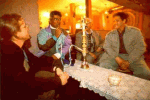 Mr. Atigheh arrived, and we departed for the mountains. The route took us through Tehran. Upon my request, we drove past the former American embassy. It is now called the U.S. Espionage Den (the new name is advertised, in Farsi and English, on the front gate) and is used to train Islamic Revolutionary Guards, Iran’s version of the KGB. Nearby was a five-story-high mural depicting an American flag. In place of the stars was a field of skulls, and written across the flag, in giant letters, in English, it read: Down with the USA. “If anyone asks where you’re from,” said Mr. Atigheh, “be sure to tell them Canada.”
Mr. Atigheh arrived, and we departed for the mountains. The route took us through Tehran. Upon my request, we drove past the former American embassy. It is now called the U.S. Espionage Den (the new name is advertised, in Farsi and English, on the front gate) and is used to train Islamic Revolutionary Guards, Iran’s version of the KGB. Nearby was a five-story-high mural depicting an American flag. In place of the stars was a field of skulls, and written across the flag, in giant letters, in English, it read: Down with the USA. “If anyone asks where you’re from,” said Mr. Atigheh, “be sure to tell them Canada.”
Iran’s ski areas were built in the early 1970s, when the final Shah, Mohammed Reza Pahlavi, still ruled. Buoyed by billions of dollars in oil revenues, the Shah had attempted to westernize Iran. He gave women the right to vote and doubled the literacy rate. He allied his nation with the United States, courted the Coca-Cola company, permitted McDonald’s restaurants to open-and developed ski resorts. Pahlavi himself became an avid skier, and Iranian racers competed in the 1972 and 1976 Olympic Games. But the Shah’s autocratic leadership style and his extensive use of the secret police led to popular unrest. Devout Muslims wanted reforms scaled back. The masses were angry that only a tiny minority profited from oil sales. On January 16, 1979, Pahlavi was overthrown.
Ayatollah Ruhollah Khomeini ascended to power and established a clergy-controlled Islamic theocracy. (There is an elected president, but he is subservient to the many ayatollahs.) Western influences were eliminated-no more Big Macs. Non-Persian music was banned. A person could be arrested for carrying a guitar. Women were forced to wear the chador; the U.S. hostages were seized; and thousands of dissenters were executed. The ski areas, emblematic of the depraved and amoral Western world, were shut down. For liberalized Iranians, dark ages had descended.
But then something curious happened. Skiing might be depraved and amoral, but several high-ranking ayatollahs were quite keen on it. Hundreds of other Iranian skiers, risking punishment, voiced their displeasure with the ban. And in one of the few cases in the past 20 years in which popular demand has triumphed over Islamic decrees, the areas reopened for business three winters after they shut down.
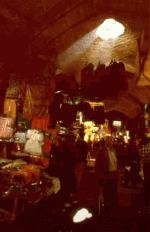 Iran is a large country, nearly the size of Alaska. Its topography is roughly soup-bowl shaped: a central desert hemmed by mountain ranges-the Zagros, the Kopet-Dag, the Elburz-all of which receive significant snowfall. Nobody I spoke with, including the director of Iranian skiing, would tell me how many ski areas the country has. No phone book has been printed since the Revolution, and any sort of information, no matter how innocuous, is guarded by the Iranian government like a state secret. My guess is 10 areas. There are five well-known resorts clustered in the mountains near Tehran, and a good estimate, culled from various brochures and pre-Revolution guidebooks, is another five scattered throughout the other ranges.
Iran is a large country, nearly the size of Alaska. Its topography is roughly soup-bowl shaped: a central desert hemmed by mountain ranges-the Zagros, the Kopet-Dag, the Elburz-all of which receive significant snowfall. Nobody I spoke with, including the director of Iranian skiing, would tell me how many ski areas the country has. No phone book has been printed since the Revolution, and any sort of information, no matter how innocuous, is guarded by the Iranian government like a state secret. My guess is 10 areas. There are five well-known resorts clustered in the mountains near Tehran, and a good estimate, culled from various brochures and pre-Revolution guidebooks, is another five scattered throughout the other ranges.
Marc and I were headed to Dizin, undoubtedly the largest and most sophisticated of the ski hills, 75 miles north of Tehran. It was Thursday, the start of the Iranian weekend. (Friday is the Muslim sabbath.) The narrow road out of Tehran was crowded with lead-footed skiers racing their Iranian-made Pecans-they look like little Peugeots-away from the city. I saw modern, top-of-the-line skis, and even a few snowboards, but nobody seemed to own a ski rack. The acceptable Iranian gear-transportation method is to stick the skis almost straight up, like a collection of antennas, through the rolled-down passenger-side window, the tails pinched between the inside of the door and the front seat.
We followed the Chalus river upstream, into the mountains. For a few miles, there were tight stands of cottonwood and sycamore, but the vegetation soon faded, replaced by intricate sandstone formations. We passed dozens of little tea houses, each with three or four tables and a brass teapot resting on a wood-burning stove. Snow lined the road. A pair of apple-sellers rubbed their hands over a roadside campfire. On the surrounding hills we could see ruins of ancient stone houses. Here and there, painted on buildings and billboards, were portraits of Iranian soldiers-bearded, sharp-eyed-who had been martyred in the eight-year war against Iraq. Women walking along the road seemed scarcely more than shadows, swathed head to toe in ebony chadors, one end of the fabric clenched between their teeth to conceal their mouths.
The road ended at the ski hill. We passed under a stone archway and into a gravel parking lot. The lifts were just shutting down, and skiers were streaming off the mountain. Dizin is big. Three gondolas and a handful of other lifts link a half-dozen high-alpine bowls, all of them rippled with hillocks and crags and webs of rambling stream beds. There is not a single tree. According to statistics printed on the trail map, Dizin receives an average of 22 feet of snow each winter. The summit elevation is 11,360 feet; the vertical drop is nearly 3,000 feet. It’s the type of place you can ski for a month and never ride the same fall-line twice.
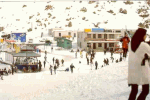 The base area, though, was sparse. There was one run-down-looking hotel, and that is where we stayed. It was a typical Iranian flimflam: $25 a night for Iranian citizens, $100 for foreigners. When the man at the front desk demanded some identification, we handed over our passports. This caused somewhat of a commotion-the desk clerk seemed neither thrilled nor upset, just disconcerted. Evidently, Marc and I were only the second group of Americans to visit Dizin since the Revolution. The mountain manager, a man named Mokhtar Seiyd, was summoned from his office to meet us.
The base area, though, was sparse. There was one run-down-looking hotel, and that is where we stayed. It was a typical Iranian flimflam: $25 a night for Iranian citizens, $100 for foreigners. When the man at the front desk demanded some identification, we handed over our passports. This caused somewhat of a commotion-the desk clerk seemed neither thrilled nor upset, just disconcerted. Evidently, Marc and I were only the second group of Americans to visit Dizin since the Revolution. The mountain manager, a man named Mokhtar Seiyd, was summoned from his office to meet us.
I liked Mokhtar immediately. He has rich, mocha skin and a demeanor so gentle it felt subversive, a deliberate counterpoint to the prevailing harshness. He was one of the few Iranianans I met who didn’t have a mustache. Mokhtar was also as close as an Iranian can get to being a ski bum: He was 38 years old and had been working at Dizin for 17 years. His English is excellent. When we talked, there was a degree of openness-a willingness to sidestep the propagandist line-that was missing from my conversations with Mr. Atigheh. I called him by his first name. And Mokhtar was unique among Iranianans I spoke with in his ability to tell ribald jokes.
We toured the base area. In addition to the hotel, Dizin contains seven small rental shops and an enormous police station. This station is a branch office for a widely feared segment of the Islamic Revolutionary Guards called the Komite, which specializes in punishing religious transgressors. The soldiers live uphill of the hotel in an lavish mansion that was originally built as a palace for the Shah. Their uniforms contain a patch depicting a bloody hand clutching a rifle.
The presence of skiing, it turns out, is still a contentious issue in Iran. Hard-line ayatollahs don’t like the sport: It promotes impure mingling of the sexes. The Komite doesn’t like it: Skiers have a history of disregarding authority. Dizin’s reputation as a place of rampant blasphemy has earned it the nickname Sin Mountain-a name, Mokhtar told me, that the skiers themselves take pride in. This angers the Komite. When the mood strikes, soldiers descend upon the mountain and harass skiers. But the soldiers’ power is limited. Several high-ranking Iranian officials ski Dizin, as do the few remaining avant-garde ayatollahs. (They aren’t very good, admitted Mokhtar.) The resort, despite some powerful opposition, continues to operate. Each winter some 200,000 Iranian skiers come for a visit.
Breakfast the next morning, in the hotel lobby, was mobbed. Bread was being baked in an igloo-shaped oven in the rear of the restaurant-flat loaves, about the thickness of a pizza, as soft and delicious as fresh tortillas. They were served with honey, goat cheese, and tea.
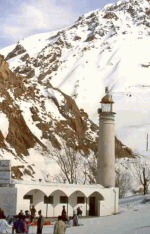 Lift tickets (same price no matter the nationality) cost 16,000 rials-about five dollars. On the front of the ticket was a photo of Alberto Tomba. The short walk to the nearest gondola took me past a small, whitewashed mosque, a new Pisten Bully grooming machine, six Iranian flags, and a billboard with a scary portrait of Ayatollah Ali Khamenei, the religious leader who replaced Khomeini after his death in 1989. The air was warm and windless.
Lift tickets (same price no matter the nationality) cost 16,000 rials-about five dollars. On the front of the ticket was a photo of Alberto Tomba. The short walk to the nearest gondola took me past a small, whitewashed mosque, a new Pisten Bully grooming machine, six Iranian flags, and a billboard with a scary portrait of Ayatollah Ali Khamenei, the religious leader who replaced Khomeini after his death in 1989. The air was warm and windless.
Marc and I boarded the four-person gondola and were joined by a pair of Iranian men. They looked to be in their early 30s; one spoke a little English. He said his name was Reza, which is what half the Iranian men I met seemed to be named. This was Reza’s first day on a new pair of Salomons, his first new pair of skis in five years, and he told me he hadn’t been able to sleep he was so anxious to try them.
That’s normal, I said. “If the weather is nice tomorrow,” added Reza, “I will skip work and ski more.” That’s even more normal, I said. At midmountain we passed over a restaurant. Reza mentioned that it was the local pizza place. Of course, I said. Ski areas are ski areas. For the first time since I’d landed in Iran, I was beginning to feel relaxed.
Then I stepped out of the gondola and headed to the top terminal’s exit.
“No!” shouted Reza. “That’s the women’s exit, to the women’s slope.”
It took me all day to figure out the rules of Iranian skiing. One of the main difficulties was that the skiing rules, like many rules in Iran, were subject to immediate change without warning. When the Komite soldiers were out, for example, the rules were completely different than when they were hanging around their palace. “Normal here,” said one of the few non-Iranian skiers I met, an official with the Canadian embassy, “is having absolutely no clue what’s normal.”
Generally, though, the rules went like this: Men and women cannot ride the lifts together. For lifts that begin at the bottom of the mountain, where the Komite is most likely to be watching, men and women must also wait on separate lift lines. For upper-mountain lifts, there is one line but still segregated ridership. An exception is married couples, who may ride together provided they are prepared to show a valid marriage certificate upon demand from a Revolutionary Guard. Women must ski with their heads completely covered-a ski hat won’t do. And if a woman’s jacket doesn’t descend below her knees, she must wear a black skirt over her ski pants to cover the offensive parts. Men can wear whatever they want. (I’m not sure how women felt about this: Islamic law forbids a woman from speaking casually to men other than her husband or relatives. So I didn’t talk with any Iranian women.) Ostensibly, men and women must also stick to different sides of the slopes-Dizin’s main runs are divided by wooden fences-but unless a large number of soldiers were present this stipulation was roundly ignored. None of this stopped women from skiing; surprisingly, there were nearly as many female skiers as male.
 At the top of the gondola, before Marc and I had taken even one run, Mokhtar appeared-he seemed to be keeping an eye on us-and insisted we meet the Dizin ski patrol. He took us to the patrol shack, an aluminum-sided hut the size of a garden shed. Inside were nine patrollers, all men, all nattily dressed in light-blue one-piece ski suits. They were crammed around a table eating flatbread and drinking tea. They jumped up and introduced themselves-Reza and Reza and Mehdi and Said and Abdhul and Nejat and Amir and Moshen and Jabar. Three more cups were produced, and Mokhtar, Marc, and I squeezed in. The door was shut. None of the patrollers spoke much English, but we took turns smiling awkwardly at one another and clinking glasses. Then we downed the tea and hurried out, primed for skiing.
At the top of the gondola, before Marc and I had taken even one run, Mokhtar appeared-he seemed to be keeping an eye on us-and insisted we meet the Dizin ski patrol. He took us to the patrol shack, an aluminum-sided hut the size of a garden shed. Inside were nine patrollers, all men, all nattily dressed in light-blue one-piece ski suits. They were crammed around a table eating flatbread and drinking tea. They jumped up and introduced themselves-Reza and Reza and Mehdi and Said and Abdhul and Nejat and Amir and Moshen and Jabar. Three more cups were produced, and Mokhtar, Marc, and I squeezed in. The door was shut. None of the patrollers spoke much English, but we took turns smiling awkwardly at one another and clinking glasses. Then we downed the tea and hurried out, primed for skiing.
The dozen of us flew down the mountain. A few inches of snow had fallen the day before we arrived, and it was still untracked. Most Iranianans are beginning or lower-intermediate skiers, and they tend to stick solely to groomed runs. We hit the fresh snow, which was already turning to corn beneath the blinding sun. The patrollers were excellent skiers, fast and wiggly-a late- ’70s sort of style-and we descended side by side across the whole of one bowl, all of us whooping loudly. A whoop’s a whoop, Farsi or English. I tumbled once, a complete somersault, and popped up coated with snow. Mehdi taught me a Farsi phrase: poudr b’zork — powder pig.
At the bottom the patrollers left to patrol, but Mokhtar stayed with us to ski. Or, rather, to drink tea. Tea-drinking is Iran’s national pastime. Before skiing again, we stepped into the gondola operators’ shack and had another cup, while drying our gloves on an old kerosene heater. Mokhtar showed me the proper Iranian way to use sugar-clench a cube between the front teeth and allow the tea to filter through. Then we took a run. Then we rested at a warming hut and drank a cup of tea. Then a run. Then we stopped at a wooden table set up aside one slope, where a man was grilling lamb kabobs over a hibachi, and drank a cup of tea. Then another run. And then time for tea at the midmountain lodge. With the exception of a small group of expert skiers, everyone on the mountain seemed to be doing this. For most Iranians, skiing apparently serves only to separate tea breaks.
The two-story midmountain lodge is the big place to hang out at Dizin. The lower level, which was filled with cigarette smoke, is reserved for men; the upper level for women and their husbands. But the real scene was out front, where people could rent beach chairs and sun themselves. Persian music was playing through a set of loudspeakers. (Persian music, which has a resemblance to John Tesh compositions, is acceptable. Rock and roll, or any type of music with a catchy beat, is out.) Everyone was drinking Zam Zam soda, which is manufactured at a pre-Revolutionary Coca-Cola plant.
Two Komite soldiers, wearing khaki pants and black jackboots, roamed about, but they did not seem to mind that there was obvious inter-sex mingling going on. I asked Mokhtar why the guards were there.
“Today, making sure all the women stay covered. Tomorrow-who knows?”
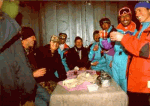 The thing I found most puzzling about the scene, however, had nothing to do with the guards. It was the ski jackets. American football, basketball, and baseball teams were advertised on the back of a startling number of parkas. In a two-minute span I spotted jackets promoting the New York Yankees, the Oakland Raiders, the Georgetown Hoyas, the Kansas City Chiefs, and something called the Chicago Giants. Even Mokhtar’s hat displayed the black-and-red logo of the Chicago Bulls.
The thing I found most puzzling about the scene, however, had nothing to do with the guards. It was the ski jackets. American football, basketball, and baseball teams were advertised on the back of a startling number of parkas. In a two-minute span I spotted jackets promoting the New York Yankees, the Oakland Raiders, the Georgetown Hoyas, the Kansas City Chiefs, and something called the Chicago Giants. Even Mokhtar’s hat displayed the black-and-red logo of the Chicago Bulls.
That’s not all. The lodge sold Winston cigarettes and Twix candy bars, both with Made in the U.S.A. printed on every package. In the hotel basement the evening before, a group of people had gathered to watch a Farsi-dubbed version of Star Wars On the drive up, I’d seen Mickey Mouse grinning from a billboard advertisement. Of the few strangers to whom I’d admitted my true nationality, not one had had a single ill word to say about America. Instead, they peppered me with endless questions about basketball, and Baywatch and Bill Clinton. Several wanted to know if I could sell them music. One man told me he would pay absolutely anything for a Whitney Houston cassette.
At the same time, the Iranian government regularly refers to the United States as the “Great Satan” and frequently issues proclamations denouncing its cultural exports. According to Mr. Atigheh, the punishment for simply carrying U.S. currency, which Marc and I both had, can be jail time. (Mr. Atigheh paid for everything in rials; we paid him dollars in private.)
“The Komite have no idea what’s written on people’s jackets,” Mokhtar told me. “And many people, educated people, really like America. Skiers here are mostly educated people.” But the explanation did little to settle my confusion. It was a typical Iranian paradox.
Near the end of the day, I rode a double chair with a young medical student named Mehryar. He complained about the absence of bars and discos in Iran, and said he could not receive a tourist visa to visit any countries other than Libya and Algeria. “But when I am skiing,” he told me, “I am as free as anyone anywhere-as free as you.”
I was moved by his sentiments, but my lift-mate was mistaken. When I came down from the hill Mr. Atigheh, who had been milling around the base area all day, casually mentioned that he’d seen the Revolutionary Guards arrest several skiers: a group of seven young men and women-unmarried and unrelated to one another-who’d made the mistake of sitting together in the hotel restaurant, and a handful of women who had improperly covered their hair. (A single visible strand is enough to warrant punishment.) Apparently, the guards at the base area were not as lax as the ones at midmountain.
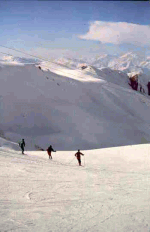 I asked what would happen to the skiers. “Oh, they were probably lectured for a few hours and then sent back to Tehran,” said Mr. Atigheh. But after a little prodding, he admitted this was just a guess. “Nobody really knows,” he said. If any were repeat offenders, a public whipping was possible, and maybe jail time. Iran is no place in which to be entangled with the law. Thieves can be sentenced to amputation of fingers. Drug dealers are executed. Public floggings are commonplace. And while it is legal for a man to have as many as four wives, if a married woman is caught sleeping with another man, both are tied together and stoned to death.
I asked what would happen to the skiers. “Oh, they were probably lectured for a few hours and then sent back to Tehran,” said Mr. Atigheh. But after a little prodding, he admitted this was just a guess. “Nobody really knows,” he said. If any were repeat offenders, a public whipping was possible, and maybe jail time. Iran is no place in which to be entangled with the law. Thieves can be sentenced to amputation of fingers. Drug dealers are executed. Public floggings are commonplace. And while it is legal for a man to have as many as four wives, if a married woman is caught sleeping with another man, both are tied together and stoned to death.
Neither Mokhtar nor Mr. Atigheh seemed the least bit troubled by the arrests. Apparently, such actions are an everyday occurrence. If anything, though, my hosts’ indifference seemed cause for greater alarm. Since I didn’t understand Iranian laws, how was I to know if I were breaking one?
Mokhtar sensed my anxiety and insisted I put the incidents out of my mind. “Let’s have some fun,” he said. He suggested we drive down the road to the first village and eat a traditional Iranian dinner.
We went to a nameless restaurant that had been converted from a one-car garage. Mokhtar ordered a dish called dizi. Dizi is a type of stew made from cubes of lamb and assorted beans. Each bowl comes with its own pestle, and before you eat you must spend several minutes mashing the stew into soup-like consistency. Then you slurp it down. Iranians eat extraordinarily fast and, save for the slurping, in complete silence. Dizi is the Iranian equivalent of a burrito: cheap, filling, and good. The meal cost the equivalent of $1.25 each.
Afterward we stopped at a tea house. The importance of tea houses in Iran cannot be overestimated. They are the Iranian surrogate for bars. At least for men; no women are allowed. Mokhtar requested a round of tea and a ghalyan –a water pipe. Out came the most magnificent hookah I have ever seen: three feet high, made of ceramic and wood, and decorated with miniature portraits of ancient Persian kings. A long, red tube emerged from the bottom of the pipe.
A tea-house worker filled a cup with coals, lit them with a match, and walked out of the shop. I followed him out. The man attached the cup to a thin chain and spun the coals, creating a circular orange contrail in front of him, like a fire dancer. When all the coals were glowing he walked back inside and set the cup atop the pipe. We began to smoke. Mokhtar and Mr. Atigheh took long, soulful drags, held in the smoke, then let it go in slow, dignified exhalations. The ghalyan bubbled peacefully. We passed around the pipe. The tobacco was smooth and delicious, as potent as beer. It made me feel as though I were floating. There were two other tables in the café, one with a group of uniformed traffic cops, the other with a trio of locals. We all smoked, a pipe at each table. When the tobacco was finished one of the locals, a fat man with a ruddy face, burst into song-a Persian folk song, Mokhtar told me. We ordered another round of tobacco and smoked it. “I’m drunk,” said Mr. Atigheh. It was almost eight o’clock-a late night by Iranian standards. Within minutes, the place cleared out. I was asleep by nine.
Saturday is an Iranian work day, so the ski area was nearly empty the next morning. At breakfast I watched the lift workers-old men, wearing wool blazers and rubber boots-come into the restaurant and stand in line, waiting for their stack of bread. All day they load lifts and pick at the bread.
Once again, Marc and I began the morning in the patrol shack. After we finished our tea, one of the patrollers produced a small bongo drum and began pounding out a beat. We clapped in unison, and the patroller began to sing. More folk music. Then the drum was passed over to Marc. He started thumping, and everybody looked at him to sing, but he shook his head and pointed across the shack at me. Everybody looked my way, still clapping, and the only thing that popped into my head was an old army marching chant. So I sang it. After a few verses every patroller was shouting out the refrain-“Left! Left! Left-right-left!”-and I sang until we dissolved into laughter and spilled out of the shack, wired and giddy, and noticed that a crowd had gathered around, wondering what the hell had been going on inside. We ignored the crowd and clicked into our skis and took a full-speed run beneath a blue blazing sky.
Afterward, I skied a few laps alone, stopping often and looking out over the whole of the Elburz range, the horizon dominated by the perfect cone of Mount Damavand, nearly 19,000 feet high. I deposited my spare change in one of the metal boxes that are posted at the top of each lift, for donations to the poor. Just before noon I stopped in the base area, near the mosque, and watched two women sled down a small hill, their chadors billowing behind them. It was a relaxed day. Even the two Revolutionary Guards patrolling the base area seemed laid back. After the women sledded, the guards walked up the same hill and slid down in their boots.
Soon came the call to prayer. Muslims are obligated to pray five times a day, and the prayer call, echoed from every mosque throughout the Islamic world, is a plaintive, hypnotic hymn, joyous and sad at the same time. People removed their ski boots and filed into the mosque-men in one door, women in another-and the area was nearly deserted. I took another run.
Late in the afternoon, Marc and Mokhtar and I met up at the midmountain lodge. For Marc and me, our time in Dizin was nearing an end. Our visas permitted us to remain in Iran only a limited number of days. The weather, though, was too nice for to rush, so we rented beach chairs and waited for the patrollers to finish their work. By the time they all showed up, the sun was ready to set. It was the time of day photographers call the magic hour. We skied our last run together as we’d skied our previous runs together-fast and nonstop, with unencumbered joy. We said goodbye in traditional Iranian man-to-man fashion, a kiss on each cheek, and then said goodbye again with a round of good old American high-fives. Mokhtar presented Marc and me each with a hand-sewn prayer mat.
Then we left. On the drive back to Tehran I replayed the visit over and over in my mind. Despite the restrictions imposed on them, the vast majority of skiers at Dizin had easily avoided any troubles-in fact, they had seemed to enjoy a relaxing weekend. Watching them instilled in me a renewed sense of the escapist pleasure, of the simple, powerful autonomy that skiing can provide.
But I couldn’t help worrying about the future of Iranian skiing. The most recent crop of ayatollahs, people had told me, are even more intolerantly fundamentalist than any before. They’ve already banned women from riding motorcycles, and horses, and bicycles. Satellite dishes have recently been prohibited; helicopters fly over Tehran looking for ones that have been smuggled in. Playing cards are now illegal, as is backgammon. Not one of the 1,500 novels submitted to the censors last year was approved for publication. College professors suspected of being unloyal to the government have been beaten. A move is underway to outlaw the Internet.
Recently, however, after a extraordinary presidential election in which the candidate endorsed by most ayatollahs was defeated, a new Iranian president, Mohammed Khatami, was inaugurated. Though he is regarded as a moderate, he must still answer to Iran’s inflexible religious leaders. (Iran’s first post-revolution president, Abolhassan Bani-Sadr, was dismissed after 17 months for offending the ayatollahs.) Even so, it is possible that the new president will be able to prevent further erosion of liberties. Perhaps he may even institute reform-I’d been told over and over during my trip that nothing ever happens as expected in Iran.
Still, my conclusion was inescapable. Iranian skiers have been extremely fortunate that their sport has remained out of the ayatollahs’ cross hairs. This good fortune can’t last forever. One day-it could be tomorrow-skiing will no longer be allowed in Iran.
A chapter excerpt from Alpine Circus written by Mike Finkel, Photography by Marc Muench
